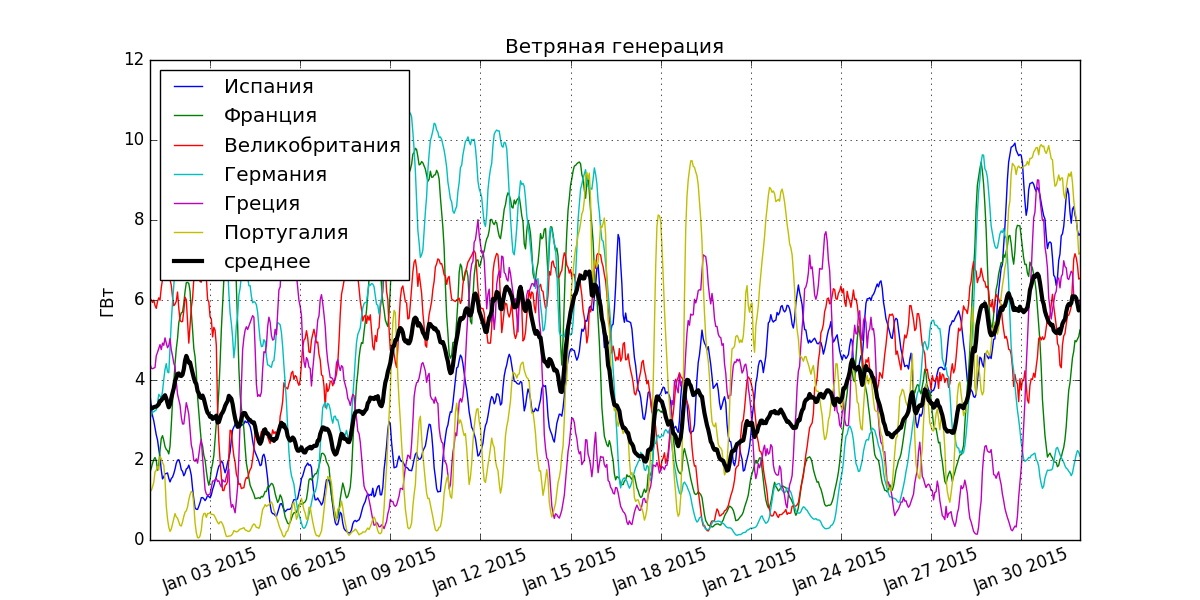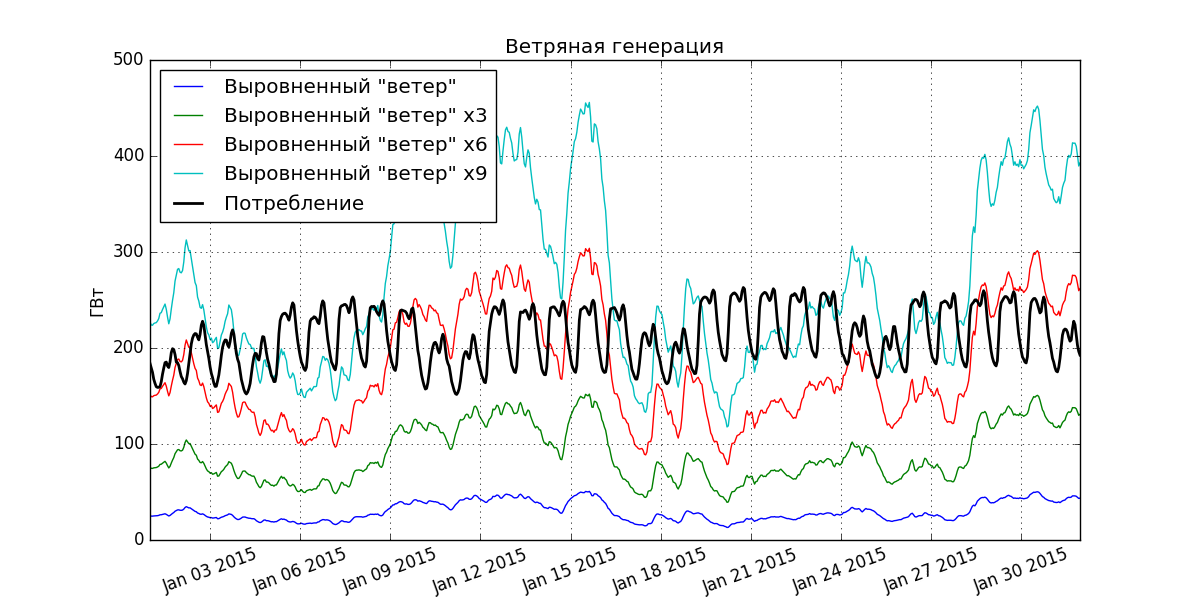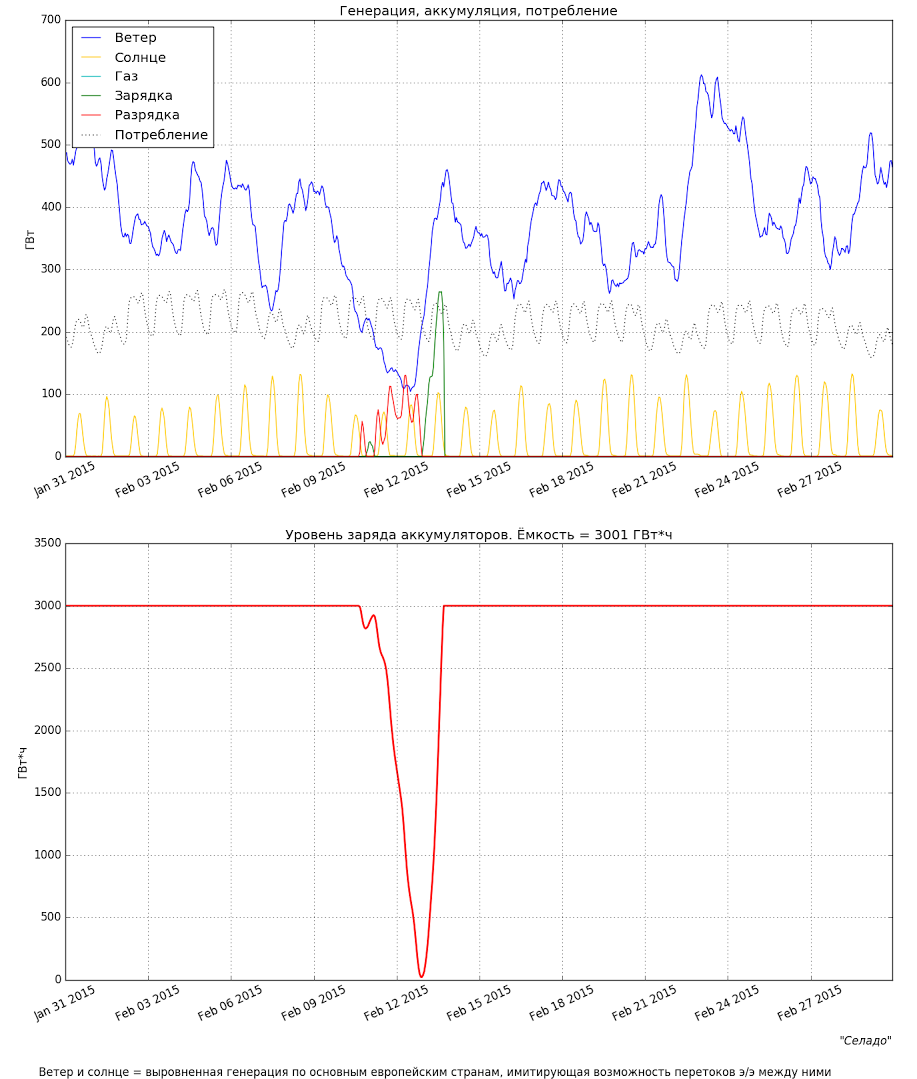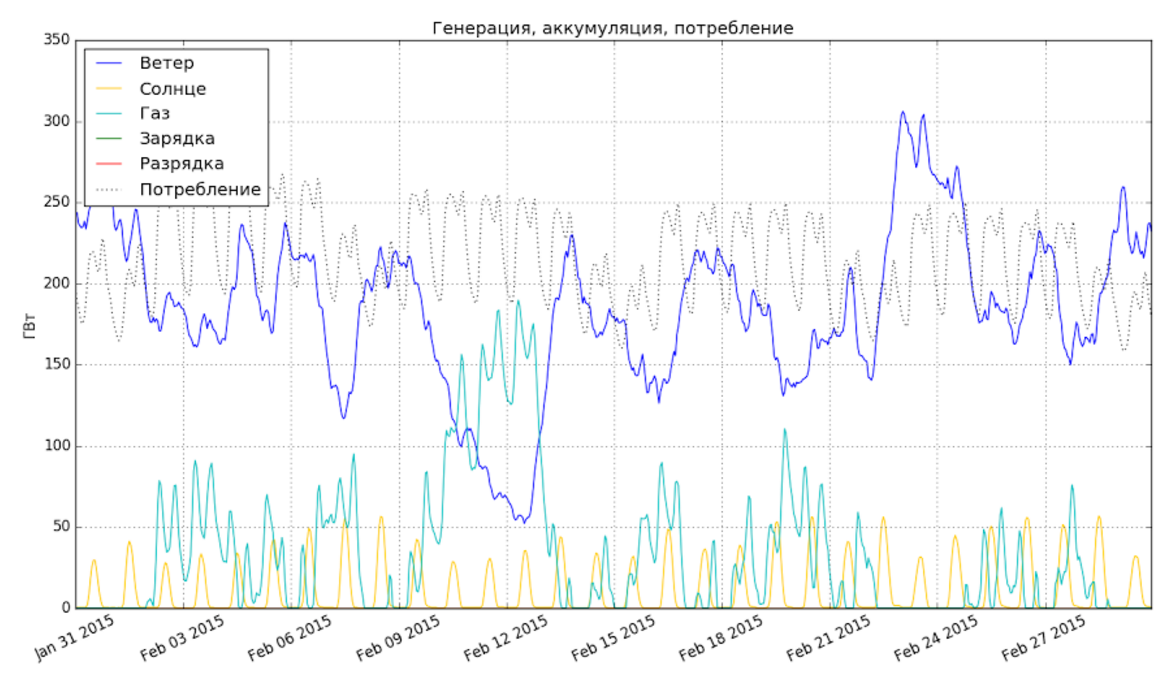Who will save renewable energy? Truth in the model - 2
Humanity wants everything, more and more appetite is growing exponentially. And any needs imply energy: if 100 years ago, humanity consumed 50 exajoules a year, today it is 500 EJ, then where can we get 5,000 EJ by the end of the century, and so on? To paraphrase a classic: “Infinity of energy is better than finiteness by the presence of infinity”. At the moment there are several solutions and one of them is Renewable Energy Sources (RES).
Electrogeneration of the twentieth century has fundamental flaws that require a modern solution: somewhere due to global warming, daytime temperatures will rise to +60, someone will flood it with the rising ocean. This concerns Russia little, but our compatriots are dying in coal mines, the life expectancy of the population is reduced due to emissions from thermal power plants, and so on. RES has a fundamental flaw that stands in the way - the inconstancy of generation.
For example, Denmark satisfies almost half of its annual energy consumption due to wind energy. The only problem of renewable energy - inconsistency of generation - the country decides to import electricity from its neighbors, who are more fortunate at this moment with the wind, the sun or something else. Thus, for a bright renewable future, the concept of overflows was born and was partially confirmed, when one country in Europe extends the hand of the “wind” or “sun” to another country and everyone seems happy, and yes even with renewables. The concept of overflows can work only in the case of wind energy, since the sun “turns off” over a sufficiently large area at night. But in addition to the flow of electricity (e / e) can be accumulated.
In words, the concepts of flow and accumulation are good, but what will happen in practice in the case of, for example, Germany? If for small Denmark there is always an extra gigawatt of neighbors, will the neighbors have an extra 60 gigawatt for Germany? And how much need to accumulate? The hypotheses are verified by experiment, which would require a second Europe with an alternative energy system. Therefore, I decided to model everything described above: wind energy flows between European countries and accumulation under conditions of real wind and solar generation.
')
Imagine that windmills and solar panels are evenly distributed throughout Europe and the whole territory is shrouded in numerous power lines, allowing you to transfer electricity from one end of Europe to the other. When calm in Germany, wind turbines are spinning in England, and if there is still wind, Spain will help out. Or Greece. I took real generation data from wind turbines in several European countries for the year 2015, rationalized them to the same power and leveled between the countries - a more even generation was obtained, emulating the cross-flows between countries. For example, January:

Generation from wind turbines has leveled off, but the effect is moderate: the differences between adjacent minimum and maximum levels are threefold. At the same time, electricity consumption is also uneven and together with the irregularities of the “wind” even greater imbalances are formed. In order to build a “wind Europe”, the aligned generation needs to be increased and the imbalances will be very significant. Below is a graph of various multiple increases in generation, where the aligned and normalized wind for European countries is taken as a unit:

The sixfold “wind” as a whole is slightly below consumption and dips are formed, when wind generation provides only 30% of the needs. If you try to close these failures with the ninefold “wind”, then there will still be holes in 100 GW, and the excess generation will be 20%. The first need something to cover, and the latter is just lost energy, which increases the cost. That is, the concept of “flows” does not solve by itself.
The second way to ensure the constancy of renewable energy is the accumulation of electricity during periods of high generation and discharge at low. In words, again, it sounds sensible, but the judge of the hypothesis is an experiment. The proposed model works simply: if the generation from the leveled and normalized “wind” and “sun” is more than the power consumption, then the batteries are charging. If less, then discharge. Consumption and solar generation are also taken from the real hourly data of European countries for 2015 year.
If the amount does not reach consumption, and the batteries are empty, then the gas generation turns on - without it, there is no way to die. Gas TPPs are a friend of renewable energy sources and, unlike coal-fired power plants, they are found in any model dedicated to future power systems. First, they can pay off, working only a couple of weeks a year - coal cannot do so because of an inappropriate cost structure (high proportion of capital expenditures). Secondly, gas TPPs have much less harmful emissions.
Playing with the model, you can see that it is extremely difficult to fully transfer power generation to renewable energy sources. Having touched 30,000 combinations of the multiplicity of “wind”, “sun” and accumulation volume, one can find the cheapest to fully meet the power consumption due to RES. Namely: 12-fold “wind” (1230 GW), 7-fold “sun” (385 GW) and 3000 GW * h of accumulation (⅔ average daily consumption). For February, one of the most inconvenient months, everything looks like this:

What catches the eye with this scenario:
1. Generation from wind turbines almost constantly exceeds consumption. This was required to close the rare failures when the wind weakens throughout Europe (February 11-12). In theory, the dips can be closed with increased solar generation or greater accumulation, but it will turn out more expensive. Therefore, in this scenario, 44% of electricity is lost, which did not fit into consumption or accumulation.
2. Accumulators are idle without work: only 8.5 charge / discharge cycles (1% of the total electricity consumption) are constantly clogged and for the year. If they are idle, it is difficult to recoup the investment, and the batteries will have to sell electricity 25 times more expensive.
3. The main role is played by the “wind” (similar to the basic generation), and the sun is on the help. If we take the installed capacity (GW), then the “wind” is 3 times more, if the generation of electricity (GW * h), which is more correct, then the “wind” is 6 times more.
4. Due to the first two factors, the cost of electricity increased from an ideal of $ 77 per MW * h (incorporated into the model as an average of the real cost) to $ 205. The cost of infrastructure for leveling plays a small role, as pales in the background of several trillion dollars to wind, sun and accumulation — that is how much it will cost at current prices. And for decades on the production, if we forget about the rest of the buyers.
In terms of size and complexity, the described power system (entirely on renewable energy) is more suitable not even in the middle of the 21st century, but at the end, and most likely, our generation will contemplate the neighborhood of quantum computers, artificial intelligence and boilers in coal and gas power plants.

Thus, humanity will have to squeeze the last juices from traditional sources of energy for many decades. By the way, the current benchmark of advanced Germany in terms of the share of renewable energy sources in 2050 is 80% .
But there are positive moments. The complexity of the energy system with the growth of the share of renewable energy grows nonlinearly and the transition from the current share in the model by 16% to the same 80% is simpler than from 80% to 100%. The combination run with the share of RES in 80% gave the following optimal combination results: 615 GW of “wind” (6x), 165 GW of “sun” (3x), 193 GW of gas generation and lack of accumulation. Same February:

Losses make up a relatively modest 6%, while the cost of electricity is $ 102.5 per MW * h. The excess over the ideal is $ 25 per MW * h, which includes losses and equalization, as well as the installation and use of gas generation.
This scenario also sheds light on the need to reserve renewable energy sources by traditional generation, in our case, gas. The maximum consumption in the model is 267 GW, and gas will have to be set at 200 GW. That is, despite the perfect alignment and the share of renewable energy in 80%, almost the entire power system will have to be backed up with traditional generation.
Regarding the lack of accumulation: at the moment it is corny very expensive (the model has a price of $ 250 per kWh). Secondly, the “wind” is not good friends with accumulation: periods of strong and weak wind last for days, respectively, and the amount of batteries needed for several days of consumption (10'000-20'000 GWh). Such a volume will rarely and little be used, which means it will be difficult to recoup. For comparison - modern world production facilities are about 100 GWh per year. The sun is much better with accumulation, which will charge and discharge the batteries every day, but due to the low winter insolation, they will have to be put too much and in the summer energy will be lost, increasing the cost.
Runs of the model on different proportions of renewable energy show that the options with the "wind" in the basis of the optimal. Below is a table for three shares of renewable energy sources, where the options with different multiplicities of “wind”, “sun” and accumulation are sorted by the cost of electricity (LCOE):

Of course, this model does not take into account a lot of things and it is unlikely the whole of Europe will be shrouded in interconnects for dozens of GW - they were interested in concepts at a fundamental level and the general situation. You can play with the model in the Telegram bot (Celado_bot) from the previous article, in a chat with which you can personally simulate the behavior of the power system by setting the parameters of “sun”, “wind” and accumulation.
So, who will save the renewable energy?) With a very big desire, you can really build the energy system entirely on renewable energy, lowering the concept to “saving” several trillion dollars (at current prices) and as a result have transcendental electricity prices. When the fractions are less than 100%, the total generation of gas can generate total energy reserve. Given that it will cost relatively little, this option does not look fantastic!
Electrogeneration of the twentieth century has fundamental flaws that require a modern solution: somewhere due to global warming, daytime temperatures will rise to +60, someone will flood it with the rising ocean. This concerns Russia little, but our compatriots are dying in coal mines, the life expectancy of the population is reduced due to emissions from thermal power plants, and so on. RES has a fundamental flaw that stands in the way - the inconstancy of generation.
Experiments with RES - there are results
For example, Denmark satisfies almost half of its annual energy consumption due to wind energy. The only problem of renewable energy - inconsistency of generation - the country decides to import electricity from its neighbors, who are more fortunate at this moment with the wind, the sun or something else. Thus, for a bright renewable future, the concept of overflows was born and was partially confirmed, when one country in Europe extends the hand of the “wind” or “sun” to another country and everyone seems happy, and yes even with renewables. The concept of overflows can work only in the case of wind energy, since the sun “turns off” over a sufficiently large area at night. But in addition to the flow of electricity (e / e) can be accumulated.
In words, the concepts of flow and accumulation are good, but what will happen in practice in the case of, for example, Germany? If for small Denmark there is always an extra gigawatt of neighbors, will the neighbors have an extra 60 gigawatt for Germany? And how much need to accumulate? The hypotheses are verified by experiment, which would require a second Europe with an alternative energy system. Therefore, I decided to model everything described above: wind energy flows between European countries and accumulation under conditions of real wind and solar generation.
')
Cross-country flows
Imagine that windmills and solar panels are evenly distributed throughout Europe and the whole territory is shrouded in numerous power lines, allowing you to transfer electricity from one end of Europe to the other. When calm in Germany, wind turbines are spinning in England, and if there is still wind, Spain will help out. Or Greece. I took real generation data from wind turbines in several European countries for the year 2015, rationalized them to the same power and leveled between the countries - a more even generation was obtained, emulating the cross-flows between countries. For example, January:

Generation from wind turbines has leveled off, but the effect is moderate: the differences between adjacent minimum and maximum levels are threefold. At the same time, electricity consumption is also uneven and together with the irregularities of the “wind” even greater imbalances are formed. In order to build a “wind Europe”, the aligned generation needs to be increased and the imbalances will be very significant. Below is a graph of various multiple increases in generation, where the aligned and normalized wind for European countries is taken as a unit:

The sixfold “wind” as a whole is slightly below consumption and dips are formed, when wind generation provides only 30% of the needs. If you try to close these failures with the ninefold “wind”, then there will still be holes in 100 GW, and the excess generation will be 20%. The first need something to cover, and the latter is just lost energy, which increases the cost. That is, the concept of “flows” does not solve by itself.
Accumulation and model
The second way to ensure the constancy of renewable energy is the accumulation of electricity during periods of high generation and discharge at low. In words, again, it sounds sensible, but the judge of the hypothesis is an experiment. The proposed model works simply: if the generation from the leveled and normalized “wind” and “sun” is more than the power consumption, then the batteries are charging. If less, then discharge. Consumption and solar generation are also taken from the real hourly data of European countries for 2015 year.
If the amount does not reach consumption, and the batteries are empty, then the gas generation turns on - without it, there is no way to die. Gas TPPs are a friend of renewable energy sources and, unlike coal-fired power plants, they are found in any model dedicated to future power systems. First, they can pay off, working only a couple of weeks a year - coal cannot do so because of an inappropriate cost structure (high proportion of capital expenditures). Secondly, gas TPPs have much less harmful emissions.
Playing with the model, you can see that it is extremely difficult to fully transfer power generation to renewable energy sources. Having touched 30,000 combinations of the multiplicity of “wind”, “sun” and accumulation volume, one can find the cheapest to fully meet the power consumption due to RES. Namely: 12-fold “wind” (1230 GW), 7-fold “sun” (385 GW) and 3000 GW * h of accumulation (⅔ average daily consumption). For February, one of the most inconvenient months, everything looks like this:

What catches the eye with this scenario:
1. Generation from wind turbines almost constantly exceeds consumption. This was required to close the rare failures when the wind weakens throughout Europe (February 11-12). In theory, the dips can be closed with increased solar generation or greater accumulation, but it will turn out more expensive. Therefore, in this scenario, 44% of electricity is lost, which did not fit into consumption or accumulation.
2. Accumulators are idle without work: only 8.5 charge / discharge cycles (1% of the total electricity consumption) are constantly clogged and for the year. If they are idle, it is difficult to recoup the investment, and the batteries will have to sell electricity 25 times more expensive.
3. The main role is played by the “wind” (similar to the basic generation), and the sun is on the help. If we take the installed capacity (GW), then the “wind” is 3 times more, if the generation of electricity (GW * h), which is more correct, then the “wind” is 6 times more.
4. Due to the first two factors, the cost of electricity increased from an ideal of $ 77 per MW * h (incorporated into the model as an average of the real cost) to $ 205. The cost of infrastructure for leveling plays a small role, as pales in the background of several trillion dollars to wind, sun and accumulation — that is how much it will cost at current prices. And for decades on the production, if we forget about the rest of the buyers.
In terms of size and complexity, the described power system (entirely on renewable energy) is more suitable not even in the middle of the 21st century, but at the end, and most likely, our generation will contemplate the neighborhood of quantum computers, artificial intelligence and boilers in coal and gas power plants.

Thus, humanity will have to squeeze the last juices from traditional sources of energy for many decades. By the way, the current benchmark of advanced Germany in terms of the share of renewable energy sources in 2050 is 80% .
A blessing in disguise
But there are positive moments. The complexity of the energy system with the growth of the share of renewable energy grows nonlinearly and the transition from the current share in the model by 16% to the same 80% is simpler than from 80% to 100%. The combination run with the share of RES in 80% gave the following optimal combination results: 615 GW of “wind” (6x), 165 GW of “sun” (3x), 193 GW of gas generation and lack of accumulation. Same February:

Losses make up a relatively modest 6%, while the cost of electricity is $ 102.5 per MW * h. The excess over the ideal is $ 25 per MW * h, which includes losses and equalization, as well as the installation and use of gas generation.
This scenario also sheds light on the need to reserve renewable energy sources by traditional generation, in our case, gas. The maximum consumption in the model is 267 GW, and gas will have to be set at 200 GW. That is, despite the perfect alignment and the share of renewable energy in 80%, almost the entire power system will have to be backed up with traditional generation.
Regarding the lack of accumulation: at the moment it is corny very expensive (the model has a price of $ 250 per kWh). Secondly, the “wind” is not good friends with accumulation: periods of strong and weak wind last for days, respectively, and the amount of batteries needed for several days of consumption (10'000-20'000 GWh). Such a volume will rarely and little be used, which means it will be difficult to recoup. For comparison - modern world production facilities are about 100 GWh per year. The sun is much better with accumulation, which will charge and discharge the batteries every day, but due to the low winter insolation, they will have to be put too much and in the summer energy will be lost, increasing the cost.
Runs of the model on different proportions of renewable energy show that the options with the "wind" in the basis of the optimal. Below is a table for three shares of renewable energy sources, where the options with different multiplicities of “wind”, “sun” and accumulation are sorted by the cost of electricity (LCOE):

Of course, this model does not take into account a lot of things and it is unlikely the whole of Europe will be shrouded in interconnects for dozens of GW - they were interested in concepts at a fundamental level and the general situation. You can play with the model in the Telegram bot (Celado_bot) from the previous article, in a chat with which you can personally simulate the behavior of the power system by setting the parameters of “sun”, “wind” and accumulation.
So, who will save the renewable energy?) With a very big desire, you can really build the energy system entirely on renewable energy, lowering the concept to “saving” several trillion dollars (at current prices) and as a result have transcendental electricity prices. When the fractions are less than 100%, the total generation of gas can generate total energy reserve. Given that it will cost relatively little, this option does not look fantastic!
Source: https://habr.com/ru/post/373281/
All Articles